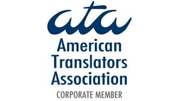Rosetta Translation provides simultaneous interpreting services to meet the needs of our clients. All our simultaneous interpreters are highly qualified in their field and have a minimum of five years of interpreting experience

Simultaneous is the most faceless and impersonal type of interpreting. More often than not, it requires the interpreter to be “behind the scenes”, often in a soundproof booth or room, and often with the aid of special interpreting equipment, headphones and microphones.
For simultaneous interpreting, our experienced, qualified interpreters exclusively work into their mother tongue.
This is useful for big-scale conferences, where there is a significant proportion of the audience who will not understand the source language. Often, more than one language pair is required.


Get a free quote by filling in the form on the right, sending an email to info@rosettatranslation, or contacting any of our offices in London, Shanghai, the US, Paris or Luxembourg.
We can provide all the required equipment for simultaneous interpreting, including interpreting booths, conference microphones and headsets. This makes us a convenient one-stop-shop for all our clients’ interpreting needs. Just contact us with your interpreting requirement, and we will guide you through the entire process.
We also offer consecutive, telephone, whispered simultaneous and liaison interpreting.

Simultaneous interpreting is very quick when compared to consecutive interpreting, and the delay from the speaker speaking and the interpreter conveying their speech can be as short as a few seconds. Additionally, there are no pauses when simultaneous interpreting is done, unlike in consecutive interpreting where the speaker has to finish what they are saying before the interpreter interprets. Due to this quality of simultaneous interpreting, it’s often considered as done in real time. Simultaneous interpreting can also be a good tool to use if there are multiple languages needed. Therefore, the common places where one might require this style of interpreting is in large conferences and political meetings, such as those held by the European Union or United Nations. Businesses can also choose to use simultaneous interpreting services, where they have time-sensitive meetings, often involving negotiations for example, where the pauses in consecutive interpreting would interrupt the flow of the meeting. Simultaneous interpreting is rarely used for informal meetings.
Simultaneous Interpreters are required to appropriately handle and use their cognitive resources to monitor and understand incoming speech, process it, extract meaning and then convert said meaning into a form which is appropriate for the target language, all while ensuring that no intention, tone or word is missed or inaccurately conveyed – all in real time. The ability to do this is a remarkable skill which is much different to that of their translator counterparts, and one that sets them aside from other linguists. Their brains bring up fascinating results when studied by neuroscientists whilst performing something which they find absolutely routine.
When interpreting, it is not just the language centres of the brain that have been shown to be active, but large swathes of it, working all in tandem. A study conducted by the International Association of Conference Interpreters (AIIC) concluded that at least four other additional areas were in use whilst they were interpreting. These were the left inferior temporal lobe, which is related to word-finding and semantic processing, the cerebellum, which is a structure associated with action-pattern storage and refinement, a portion of the left inferior frontal gyrus involved in the retrieval and maintenance of semantic information, and the supplementary motor area, which is involved in planning speech output. Even more surprisingly, there was evidence that simultaneous interpreting also creates activity in the Basal ganglia, a part of the brain more commonly known as the reptilian brain. Simultaneous interpreters even had a noticeable change to their right caudate nucleus, which is right at the core of the brain, based in the basal ganglia, as compared to before their training as an interpreter. It’s like an orchestral conductor, coordinating activity across several regions of the brain to produce stunningly complex, intricate behaviours.
You can see therefore how remarkable and skilled interpreters have to be that can perform Simultaneous Interpreting, and you can expect the very best of them when you book Simultaneous Interpreting with Rosetta Translation.
As simultaneous interpreting is so cognitively demanding, we will often ask for reference material for the conference or meeting, so that they can ensure they familiarise themselves with any specific terminology and ensure they are ready for whatever the speaker might say. A key skill a simultaneous interpreter has is also the ability to pre-empt and successfully predict the words a speaker will say, a quality which was first demonstrated 20 years ago in a simple experiment devised by Franco Fabbro and his colleagues at the University of Trieste in Italy. This skill means an increase in the speed at which your interpreter will be able to produce the spoken translation. Simultaneous interpreters also require a bit of kit to successfully do their job, such as a soundproof booth and high-quality set of microphones and headsets. They often work in pairs, with one interpreter working with one language pair, and the other doing the inverse. This means that there is even less delay between speakers and their translation. Additionally, as simultaneous interpreting can be so mentally demanding, some may work in further pairs, switching out during longer meetings or conferences so that one may have a mental break while the other interprets. This ensures continuous and seamlessly high-quality interpreting from beginning to end.
When you request a quote from Rosetta Translation for simultaneous interpreting, you can be sure that you are getting highly qualified and experienced interpreters, including the technology required, to make sure your event or conference goes along without a hitch. Get in touch for a quote today.
Quality is paramount at Rosetta Translation. Customers can rest assured that we will always choose highly experienced and qualified interpreters for each assignment. Our focus on quality is underlined by the fact that Rosetta is ISO 9001:2008 certified and has achieved the DIN EN 15038 certification as well.






What is the UN French Language Day? On 20 March, we once again celebrate UN French Language Day, a global celebration of linguistic diversity and cultural exchange. Created by the United Nations in 2010, this day is to remind us …


© 2025 All Rights Reserved